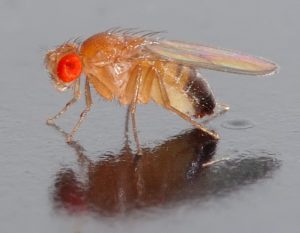Vismodegib – A Breakthrough in Basal Cell Carcinoma Treatment
Vismodegib, a Hedgehog Pathway Inhibitor, has been recently shown to be highly effective for advanced basal cell carcinoma in Phase II clinical studies. Discovery of the Hedgehog Signaling Pathway is enlightening in how three unrelated basic science research paths can meet at crossroads of cancer treatment breakthrough.

First, there were sheep in Idaho in 1957 that grazed on wild corn lilies and produced one-eyed lambs. Second, there were Drosophila fruit flies whose DNA was mapped and studied extensively. Lastly, there were families of autosomal dominant inheritance of multiple basal cell carcinomas. These three crossed paths at vismodegib – the first breakthrough drug for targeted basal cell carcinoma treatment.
 As you may recall from our previous blog, the cyclopic sheep’s mothers turned out to have grazed on a teratogen – later named cyclopamine. When fruit fly research identified Hedgehog genes (mutations that made fly larvae appear as hedgehogs), a connection was made to the cyclopamine genetic target – Hedgehog signaling pathway. The one-eyed lamb mystery was then solved. The genetic study of hereditary basal cell carcinomas families (Gorlin syndrome) then identified the genetic mutation – Hedgehog Signaling Pathway again. Cyclopamine was modified, and from wild corn lilies, vismodegib was born.
As you may recall from our previous blog, the cyclopic sheep’s mothers turned out to have grazed on a teratogen – later named cyclopamine. When fruit fly research identified Hedgehog genes (mutations that made fly larvae appear as hedgehogs), a connection was made to the cyclopamine genetic target – Hedgehog signaling pathway. The one-eyed lamb mystery was then solved. The genetic study of hereditary basal cell carcinomas families (Gorlin syndrome) then identified the genetic mutation – Hedgehog Signaling Pathway again. Cyclopamine was modified, and from wild corn lilies, vismodegib was born.
 Over 90% of the sporadic basal cell carcinomas (BCC) have mutations of the Hedgehog Pathway. As a result, clinical trials began several years ago with vismodegib, a Hedgehog inhibitor. The recent phase II clinical studies have shown that ¾ of advanced inoperable BCC had a clinical benefit with the drug – response and disease stabilization. Responses were described as “huge … with major decrease in tumor size”. Similar findings were reported with Gorlin syndrome patients. Treatment was administered orally for up to 18 months in these studies. Gorlin syndrome patients had dramatic clearance of dozens of BCC lesions and in some cases all of BCC lesions.
Over 90% of the sporadic basal cell carcinomas (BCC) have mutations of the Hedgehog Pathway. As a result, clinical trials began several years ago with vismodegib, a Hedgehog inhibitor. The recent phase II clinical studies have shown that ¾ of advanced inoperable BCC had a clinical benefit with the drug – response and disease stabilization. Responses were described as “huge … with major decrease in tumor size”. Similar findings were reported with Gorlin syndrome patients. Treatment was administered orally for up to 18 months in these studies. Gorlin syndrome patients had dramatic clearance of dozens of BCC lesions and in some cases all of BCC lesions.
The limitation of vismodegib have been drug side effects. Over 30% of patients experienced mostly mild grades of taste loss, muscle spasms, alopecia, weight loss, and fatigue. More severe but uncommon side effects included hyponatremia and pyelonephritis. Around 20% of patients stopped treatment because of side effects.

Various treatment regimens have been proposed. In advanced BCC, vismodegib could at least be used in a neo-adjuvant role to shrink the disease prior to resection in order to limit the surgical morbidity. Vismodegib could become the primary mode of therapy in basal cell carcinomas in patients that tolerate the drug. In Gorlin syndrome patients, use of the drug could involve regular trials of 6-12 months spaced one year apart as the patients continuously produce BCC. Combination of vismodegib with cytotoxic drugs such oral capecitabine (Xeloda, fluorouracil relative) could be another option.

A future exploration of this class of drug will likely involve topical formulations of Hedgehog pathway inhibitors. For now, of the nearly 50 trials of Hedgehog inhibitors in the U.S., there are currently 4 trials evaluating oral Hedgehog pathway agents for basal cell carcinomas. Genentech, a subsidiary of Roche Group, has filed for a new drug application with the US Food and Drug Administration and has sponsored and conducted most of the above studies. We will keep you posted on the exciting developments in this subject. One thing we have learned from all this is that Idaho corn lilies and fruit flies are helping cure cancer.
